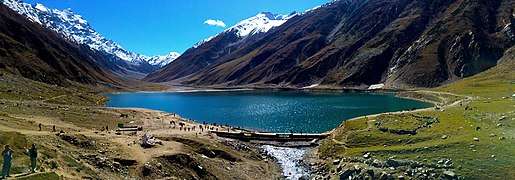Lake Saiful Muluk
Saiful Muluk (Urdu: جھیل سیف الملوک) is a mountainous lake located at the northern end of the Kaghan Valley, near the town of Naran in the Saiful Muluk National Park. At an elevation of 3,224 m (10,578 feet) above sea level, the lake is located above the tree line, and is one of the highest lakes in Pakistan.
| Lake Saiful Muluk | |
|---|---|
 The lake is notable for its picturesque setting in the mountains of northern Pakistan | |
| Location | Saiful Muluk National Park Kaghan Valley |
| Coordinates | 34.876957°N 73.694485°E |
| Lake type | Alpine, glacial lake |
| Primary inflows | Glacial water |
| Primary outflows | Kunhar River |
| Basin countries | Pakistan |
| Surface area | 2.75 km2 (1.06 sq mi) |
| Max. depth | 113 ft (34 m) |
| Surface elevation | 3,224 metres (10,577 ft)[1] |
| Settlements | Naran |
Location
Saiful Muluk is located in the Mansehra district of Khyber Pakhtunkhwa, about 9 kilometres (5.6 mi) north of Naran,[2][3] in the northern part of Kaghan Valley. Malika Parbat, the highest peak in the valley is near the lake.[4]
The lake is accessible from the nearby town of Naran during the summer season but access during winter is limited.
Physical features
Saiful Muluk was formed by glacial moraines that blocked the water of the stream passing through the valley.[5] The Kaghan Valley was formed in the greater Pleistocene Period dating back almost 300,000 years when the area was covered with ice. Rising temperatures and receding glaciers left a large depression where glaciers once stood. Melting water collected into the lake.

Ecology
The lake has rich eco-diversity and holds many species of blue-green algae. Large brown trout are found in the lake, up to about seven kilograms.[6] About 26 species of vascular plant exist in the area, with Asteraceae the most commonly found species. Other species commonly found in the region are: Ranunculaceae, Compositae, Cruciferae, Gramineae, Apiaceae, Leguminosae, Scrophulariaceae and Polygonaceae.
Folklore
The Lake Saiful Muluk is named after a legendary prince. A fairy tale called Saif-ul-Muluk, written by the Sufi poet Mian Muhammad Bakhsh, talks of the lake.[7][8] It tells the story of the prince of Persia named Prince Saiful Malook who fell in love with a fairy princess named Princess Badri-ul-Jamala at the lake.[9]
Gallery
Hover the mouse click or tap on the following images to see their captions.
 Lake Saiful Muluk under clouds
Lake Saiful Muluk under clouds A view of lake in Winter
A view of lake in Winter Lake Saiful Muluk in a sunny day
Lake Saiful Muluk in a sunny day A full view of Lake Saif-ul-Muluk
A full view of Lake Saif-ul-Muluk Lake Saif ul Malook in May 2017
Lake Saif ul Malook in May 2017 The lake freezes over in winter
The lake freezes over in winter Lake Saif ul Muluk in December 2012
Lake Saif ul Muluk in December 2012 Tourist point with Lake
Tourist point with Lake A boat in Saiful Maluk Lake
A boat in Saiful Maluk Lake Lake Saif-Ul-Mulook, Kaghan Valley, Pakistan
Lake Saif-Ul-Mulook, Kaghan Valley, Pakistan_Abdul_Majid.jpg) Lake Saif-Ul-Mulook at night
Lake Saif-Ul-Mulook at night
See also
- Lulusar Lake
- Katora Lake
- Dudipatsar Lake
- Mahodand Lake
- Ratti Gali Lake
References
- "Surface Elevation of Lake Saiful Muluk". Dailytimes.com.pk. Retrieved 1 June 2018.
- "Distance from Naran". Google Maps. Retrieved 10 June 2018.
- Ali, Ihsan. "Natural Heritage of Kaghan Valley". Mapping and Documentation of the Cultural Assets of Kaghan Valley, Mansehra (PDF) (Report). Islamabad: UNESCO. p. 46. Retrieved 20 September 2012.
- Hussain, Manzoor; Khan, Mir Ajab; Shah, Ghulam Mujtaba (5 March 2006). "Traditional Medicinal and Economic uses of Gymnosperms of Kaghan Valley, Pakistan". Ethnobotanical Leaflets. 10: 72. ISSN 1948-3570. Retrieved 20 September 2012.
- Ehlers, J.; Gibbard, P. L. (29 July 2004). Quaternary Glaciations - Extent and Chronology (2 ed.). Elsevier. pp. 305–306. ISBN 978-0444515933. Retrieved 16 September 2012.
- Muhammad Yaqoob (14 March 2003). "Production and culture of trout in the Northwest Frontier Province and Northern Areas of Pakistan, A review". In Peter, T.; Swar, S. B. (eds.). Cold water fisheries in the trans-Himalayan countries. Rome: Food and Agriculture Organization. p. 327. ISBN 978-9251048078. Retrieved 16 September 2012.
- http://windsweptwords.com/2013/04/27/the-legend-of-Saif-ul-Muluk-part-iv/%5B%5D
- "The News International: Latest News Breaking, Pakistan News". www.thenews.com.pk.
- Javed, Asghar (23 June 2002). "Pristine lakes of the north". Dawn. Archived from the original on 13 July 2007. Retrieved 10 September 2016.
External links
| Wikimedia Commons has media related to Saiful Muluk Lake. |